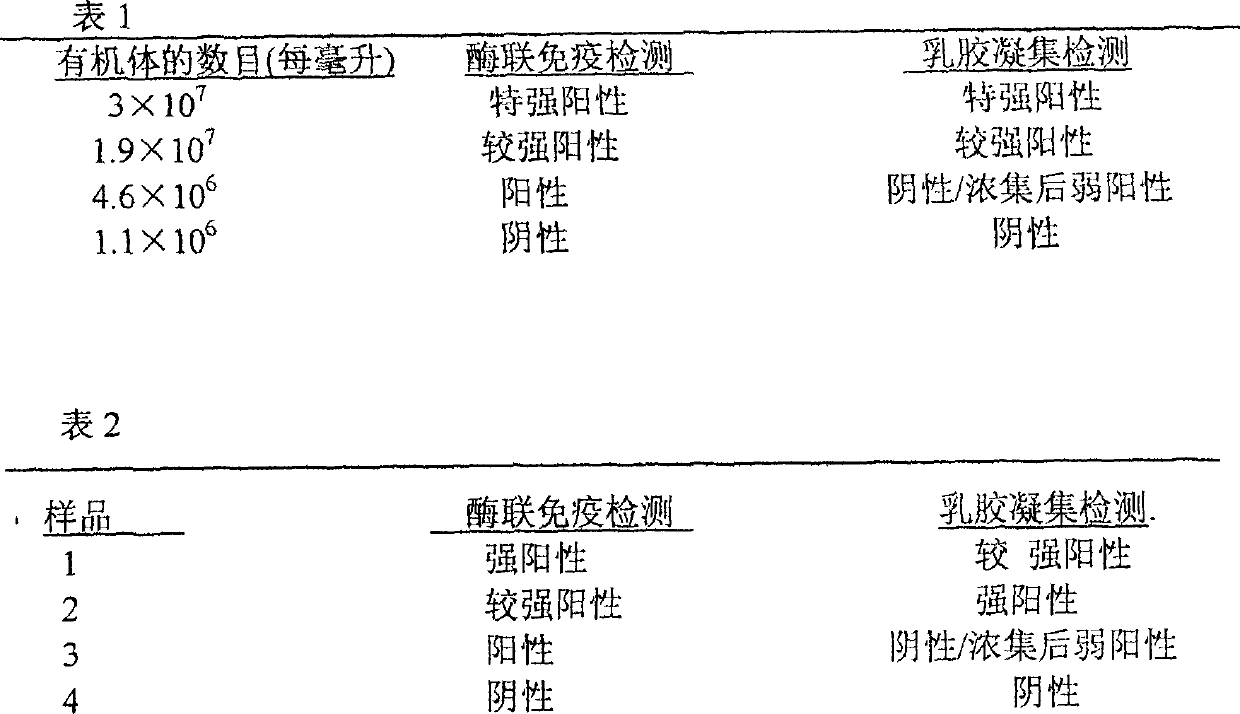Immunological microball method for detecting pyloric helicobacterium in stool sample
A Helicobacter pylori and anti-Helicobacter pylori technology, which is applied in the directions of measuring devices, biological tests, material inspection products, etc., can solve the problems of high cost of reagents and instruments, time-consuming operation, etc., and achieves reliable results, low cost, and convenient and fast operation. Effect
- Summary
- Abstract
- Description
- Claims
- Application Information
AI Technical Summary
Problems solved by technology
Method used
Image
Examples
Embodiment 1
[0044] Example 1: Physical method sensitization of microspheres
[0045] Material preparation: polystyrene microspheres with a diameter of 0.6-1.2 microns (available from SIGMA, USA), goat polyclonal antibody against Helicobacter pylori, Helicobacter pylori antigen (antigen standard or soluble antigen) (available from KPL, USA) Company, Shenzhen Jingmei Biological Engineering Co., Ltd., China).
[0046] Buffer preparation:
[0047] 0.27mol / L glycine buffer solution: 7.51g glycine and 9.95g sodium chloride were dissolved in distilled water, adjusted to pH 8.2 with 1mol / L sodium hydroxide, and made up to 1 liter with distilled water.
[0048] 0.27mol / L glycine buffer + 1% human serum albumin: 1 g of human serum albumin is dissolved in 100 ml of 0.27mol / L glycine buffer.
[0049] 0.054mol / L glycine buffer solution: Dilute 0.27mol / L glycine buffer solution 1:5 with distilled water.
[0050] First dilute 1 milliliter of 10% latex suspension to 1-2% with distilled water, wash and...
Embodiment 2
[0051] Embodiment 2: chemical cross-linking method sensitization microspheres
[0052] Polyaldehyde-based polystyrene microspheres with aldehyde groups Add 0.1 mg of antibody or antigen to 1 ml of 1% latex, add 10 ml of 0.1 mol / L pH5.3 acetate buffer. The vessel was allowed to stir for 10 hours at room temperature, then centrifuged at 10,000g for 20 minutes and the supernatant removed. Add 10 ml of pH9.5 1mol / L ethanolamine / 0.1% Tween-20 to the precipitate. Stir for 3 hours, then centrifuge at 10,000 g for 20 minutes, and remove the supernatant. Add 10 ml of Tris buffer to the precipitate, stir for 24 hours, centrifuge at 10,000 g for 20 minutes, and remove the supernatant. Add 10 ml of phosphate buffer solution containing 1% human serum albumin, resuspend; add 0.04% sodium azide, store at 4°C, and set aside.
[0053] 0.1mol / L pH5.3 acetate buffer solution: 10ml of 0.1mol / L acetic acid, 40ml of 0.1mol / L sodium acetate.
[0054] Tris buffer: 0.05mol / LTris 0.1mol / sodium chlo...
Embodiment 3
[0055] Example 3: Fecal sample preparation
[0056] Dilute the stool sample 1:4 or 1:6, add the appropriate stool sample into the sample diluent, and mix thoroughly. Centrifuge at 200 rpm for 3 minutes. Take the supernatant for testing. When using agglutination reaction and agglutination inhibition reaction to detect Helicobacter pylori, in order to improve the detection sensitivity, the sample can be concentrated, the supernatant is centrifuged at 12000g for 15 minutes, the supernatant is removed, and the precipitate is dispersed and mixed. to be tested.
[0057] Sample diluent: 100 ml of 0.27mol / L glycine buffer, add 1 g of human serum albumin, add 3 ml of Tween-20. At the same time, add 0.04% sodium azide.
PUM
| Property | Measurement | Unit |
|---|---|---|
| Diameter | aaaaa | aaaaa |
| Diameter | aaaaa | aaaaa |
Abstract
Description
Claims
Application Information
 Login to View More
Login to View More - R&D
- Intellectual Property
- Life Sciences
- Materials
- Tech Scout
- Unparalleled Data Quality
- Higher Quality Content
- 60% Fewer Hallucinations
Browse by: Latest US Patents, China's latest patents, Technical Efficacy Thesaurus, Application Domain, Technology Topic, Popular Technical Reports.
© 2025 PatSnap. All rights reserved.Legal|Privacy policy|Modern Slavery Act Transparency Statement|Sitemap|About US| Contact US: help@patsnap.com

